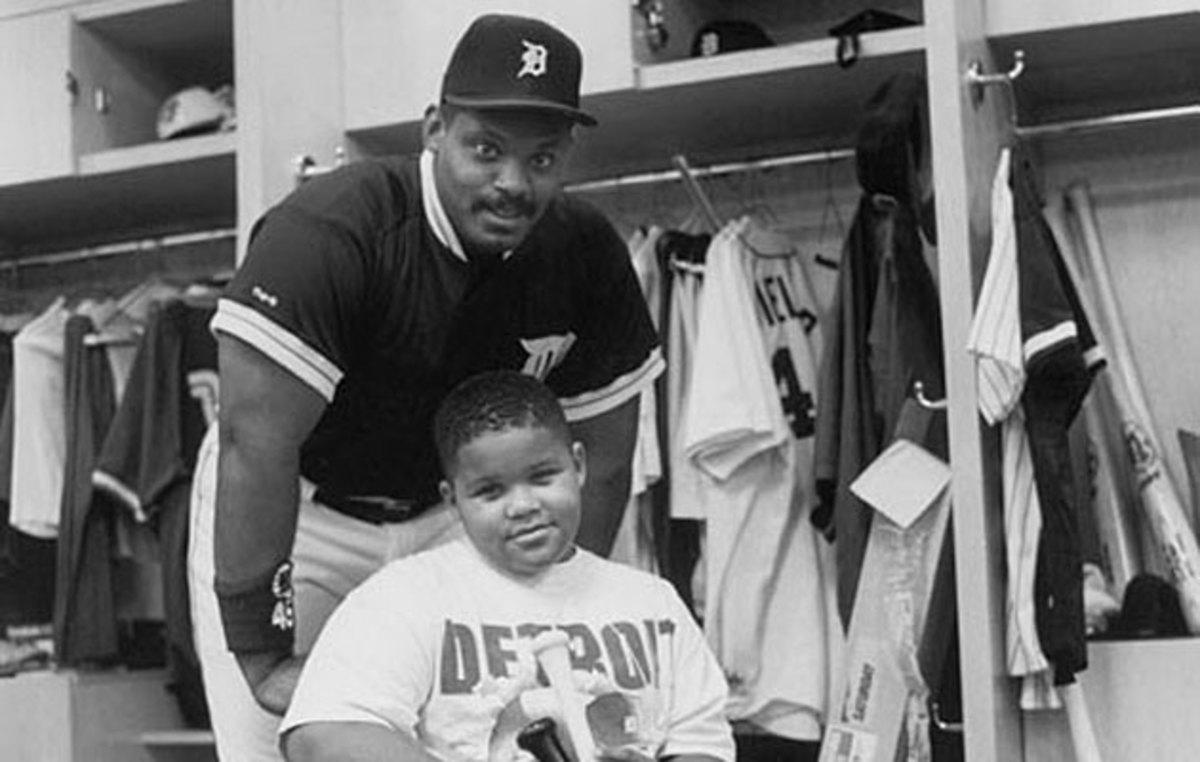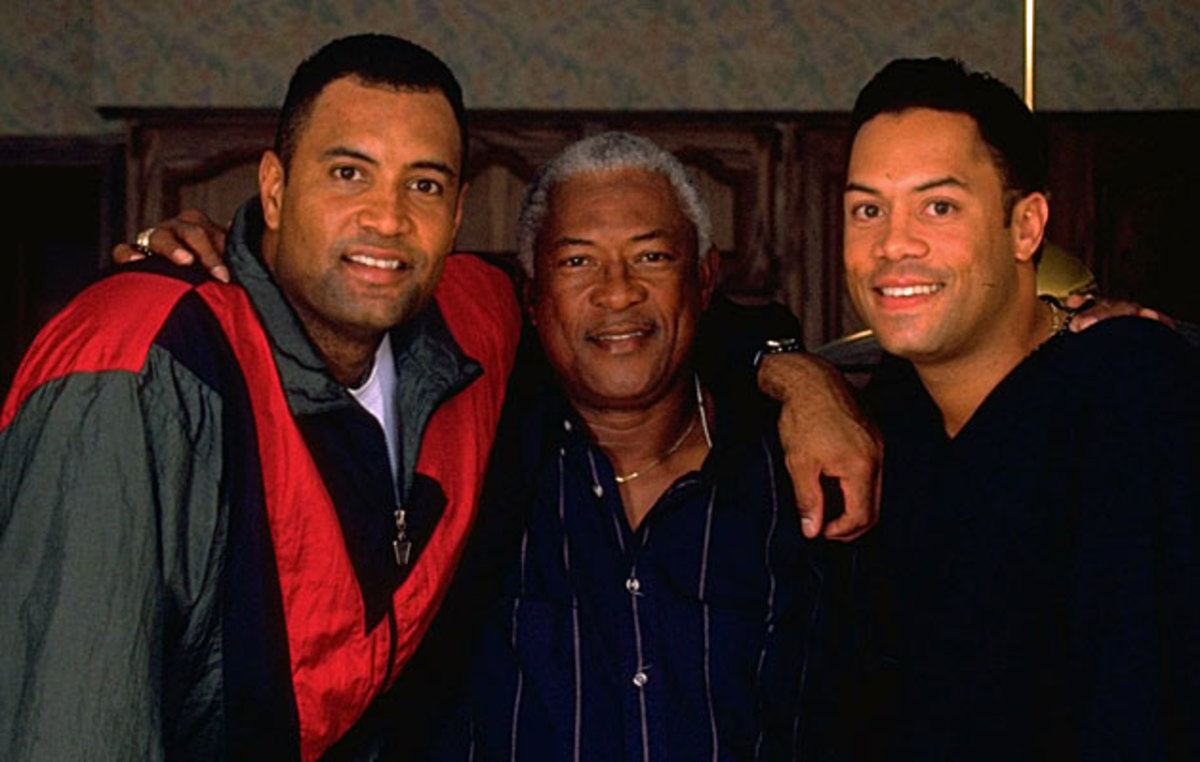Boone, Bell among MLB sons who outshone their father's careers

Your teams. Your favorite writers. Wherever you want them. Personalize SI with our new App. Install on iOSor Android.
Sunday is Father’s Day, a holiday which has particular resonance in Major League Baseball, not only because of the tradition of fathers passing their love of the game on to their sons and daughters, but because of the number of major leaguers whose fathers also played major league baseball. There have been 229 sons of big leaguers who themselves reached the majors, including roughly two dozen men currently on MLB rosters. As remarkable as it is to have two generations of major leaguers in a single family, any man who chooses to pursue the same career as a successful father knows that those fathers can cast a long shadow out from which it can be difficult to emerge into the light. Just ask Joe Buck.
Further evidence of this is the fact that, of all of the men in baseball history to compile 10 or more wins above replacement in their careers (Baseball-Reference version), just seven have had sons who have proven to be more valuable major leaguers by that same measure. Two of those you know well: Barry Bonds, son of Bobby, and Ken Griffey Jr., son of Ken. The other five may not leap as easily to mind.
To be fair, there have been several near misses. Moises Alou compiled 39.7 bWAR, not far behind the 42.2 of his father (and one-time manager) Felipe. Adam LaRoche, who retired this spring due to his desire to spend time with his own son, fell just 0.2 bWAR shy of his father Dave’s 14.3 career mark. Todd Hundley finished his 14-year career with 10.8 bWAR, compared to the 11.6 of his father and fellow catcher Randy. David Segui wound up with 10.4 bWAR, while his father, Diego, had 12.1. Bret Boone and his younger brother Aaron are part of the rare three-generation family in baseball history, and while their respective totals of 22.6 and 13.5 bWAR are impressive, those numbers fell short of both their father and their grandfather.
The families below are listed in order of the longest shadows cast by the fathers, i.e., the dads with the best career bWAR. In case you're curious, Barry Bonds' career mark of 162.4 nearly tripled the 57.7 of his three-time All-Star father, and Junior Griffey finished with 83.4 in his Hall of Fame career, more than double the 34.4 of his dad, also a three-time All-Star.
1. The Boones
Father: Ray Boone, 25.8 bWAR
Son: Bob Boone, 27.3 bWAR
The Shadow: Ray Boone played parts of 13 seasons in the major leagues from 1948 to '60, emerging as Lou Boudreau’s slick-fielding replacement at shortstop with the Indians but finding his greatest success after a mid-season trade to the Tigers, who moved him to third base, in 1953. From '53 to '56, Boone hit .295/.379/.494 (135 OPS+) while averaging 23 home runs and 99 RBIs per season. He finished eighth in the American League’s Most Valuable Player voting in ’53, was the AL’s starting third baseman in the All-Star game in '54, led the league with 116 RBIs in '55, and made a second All-Star team in '56. He also picked up some down-ballot MVP votes in ’54 and ’55.
The Light: A third baseman at Stanford, Robert Raymond Boone was drafted by the Phillies in 1969. He was moved to catcher in 1971, the same year Philadelphia drafted an Ohio University shortstop named Mike Schmidt. Both players reached the majors in '72 and helped the franchise enjoy what to that point was its most successful stretch ever, one in which the Phils made the postseason five times in six years from 1976 to '81, winning the World Series for the first time in 1980. A highly-regarded defensive catcher, Boone was a central figure on those teams, making three All-Star teams (starting for the NL in '79), winning two Gold Gloves and drawing some down-ballot MVP votes in '78.
Boone was sold to the Angels after 1981, a season in which, as a prominent player representative, he played a key role off the field in the strike that wiped out almost two months of games. He made another All-Star team in 1983, won five more Gold Gloves and went 10-for-22 with a home run for California in the 1986 American League Championship Series. The next year he set the major league record (since broken by Carlton Fisk and Ivan Rodriguez) for most games at catcher. He retired after spending the 1990 season, his 19th, with Kansas City. He later spent six seasons managing the Royals and Reds. At the latter stop, he managed his son Aaron before being fired—and Aaron being traded—within a few days of each other in July 2003.
• Bret Boone on the night of his brother Aaron's famous HR
2. The Fielders
Father: Cecil Fielder, 17.1 bWAR
Son: Prince Fielder, 23.9 bWAR
The Shadow: Drafted by the Royals in 1982, traded to the Blue Jays in '83 and sold to Japan’s Hanshin Tigers in '88, Cecil Fielder didn’t emerge as a star in the major leagues until returning from Japan to join Detroit’s Tigers for his age-26 season in 1990. That year, he set the league on fire, becoming the first man since George Foster in 1977 to hit 50 or more home runs in a season. Fielder led the majors in homers and RBIs in both ‘90 and ‘91, finishing second in the AL MVP voting, winning the Silver Slugger and making the All-Star team in both seasons. He led the AL in RBIs again in 1992, made another All-Star team team in '93 and over a seven-year span from 1990 to '96 averaged 37 home runs and 114 RBIs per season. Traded to the Yankees at the deadline in ’96, he hit .308/.390/.519 that October as New York won its first World Series title since 1978.

The Light: Famous for clouting batting practice home runs in Tiger Stadium as an adolescent, Prince was selected seventh overall by the Brewers in the 2002 draft. Five years later, in his second full major league season, he led the National League with 50 home runs, making the Fielders the only father-son combination to each hit 50 homers in a single major league season. A six-time All-Star, Fielder has thrice started the Midsummer Classic at first base. He has also finished in the top four in the NL MVP voting three times, while winning three Silver Sluggers and two Home Run Derbies. Over a seven-year span from 2007 to '13, Fielder averaged 36 home runs and 111 RBIs per season. He has also made the postseason five times with three different teams and was a key figure in helping Milwaukee end a 26-year postseason drought in 2008 and in the Tigers reaching the 2012 World Series.
3. The Bells
Father: Gus Bell, 15.3 bWAR
Son: Buddy Bell, 66.1 bWAR
The Shadow: A major league outfielder from 1950 to '64, Gus Bell reached the majors as a rightfielder with the Pirates, with whom he led the NL in triples with 12 in 1951. His greatest success, however, came as a centerfielder with the Reds, to whom he was traded after the '52 season. Bell made four All-Star teams in his first five seasons in Cincinnati, starting the game in centerfield in 1954 and ’56, and drawing some down-ballot MVP votes for his first season with the Reds in which he hit .300/.354/.525 (125 OPS+) with 30 home runs and 105 RBIs. He drove in 115 runs in 1959, though he was past his prime by then. In his first four years with Cincinnati, Bell hit a combined .300/.353/.500 (120 OPS+).
The Light: Buddy Bell was one-and-done on the Hall of Fame ballot in 1995, but he deserved better. Considered one of the best fielding third basemen of all time, Bell won six Gold Glove awards and he also made five All-Star teams. He never put up the kind of eye-catching offensive totals his dad managed, but during his five-year peak with the Rangers from 1980 to '84, the younger Bell hit .301/.366/.443, good for a 127 OPS+ in a more pitching-friendly era. When you factor in his fielding, he was worth an average of six wins above replacement per season over a six-year span from 1979 to '84. His JAWS score of 53.2 ranks 15th all-time among all third baseman, ahead of the likes of Ken Boyer, Dick Allen and Darrel Evans, and just shy of the Hall of Fame standard of 55.1 at a position that remains underrepresented in Cooperstown.
David Bell, Buddy's son and Gus's grandson, compiled 15.2 bWAR in a 12-season career that ended with the Brewers in 2006.
• Subscribe to get the best of Sports Illustrated delivered right to your inbox
4. The Javiers
Father: Julian Javier, 13.8 bWAR
Son: Stan Javier, 25.5 bWAR
The Shadow: The slick-fielding second baseman of the great Cardinals clubs of the 1960s, Javier made the All-Star team in '63 and '68, finished ninth in the NL MVP voting in '67 and won three pennants and two World Series with St. Louis. In the Fall Classics of 1967 and '68 Javier hit a combined .346/.381/.481.
The Light: Named after Javier’s former teammate Stan Musial andsigned by the Cardinals as a 17-year-old in 1981, Stan Javier was traded twice, the second time as part of the package that sent Rickey Henderson to the Yankees after the 1984 season, before establishing himself as a major leaguer with the Bash Brothers A’s of the late '80s. Javier appeared in the 1988 and ’89 World Series for Oakland, then continued on what would be a 17-year career as a journeyman that crested in his early 30s, when he proved to be a valuable, slick-fielding and switch-hitting fourth outfielder, posting a .281/.360/.390 (102 OPS+) line for the Angels, A’s and Giants from 1993 through '98. He finished his career hitting .292/.375/.391 (109 OPS+) in 323 plate appearances for the 116-win Mariners in 2001.

5. The Alomars
Father: Sandy Alomar, 10.6 bWAR
Sons: Roberto Alomar, 66.8 bWAR; Sandy Alomar Jr., 13.7 bWAR
The Shadow: Sandy Alomar Sr. was a slick-fielding second baseman, like the elder Javier, but he was a terrible hitter. However, he did manage to make the American League All-Star team in 1970, and he was well-regarded as a switch-hitter with speed over the course of a 15-year career from 1964 through '78, the best years of which came with the California Angels in the early 1970s.
The Light: Roberto Alomar was a Hall of Fame second baseman who made 12 consecutive All-Star teams from 1990 to 2001, won 10 Gold Gloves and four Silver Sluggers, and five times finished in the top six in the AL MVP voting. His brother Sandy Alomar Jr. was a major league catcher for parts of 20 seasons, making three All-Star teams, picking up some mid-ballot MVP votes in 1997 and winning the Gold Glove and the AL Rookie of the Year award in 1990.
Both of the younger Alomars were signed by the Padres in the early 1980s and made their major league debuts with San Diego in 1988, when Sandy Sr. was a coach for the team, but went on to have their greatest success with other teams. Sandy Jr. was traded to Cleveland with Carlos Baerga and Chris James for Joe Carter in December 1989. A year later, Roberto was traded with Carter to the Blue Jays in the blockbuster deal for Fred McGriff and Tony Fernandez. The two brothers would reunite in Cleveland in 1999 and 2000 and, far less successfully, with the White Sox in 2003 and ’04. Sandy Sr. would later coach Sandy Jr. with the Mets in 2007, the latter’s final season as a player, and the two would work together on the Mets’ coaching staff in 2008 and ’09.
